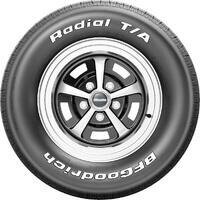What are Radial Tyres?
Radial tyres are a type of tyre construction that is widely used in modern vehicles. The term "radial" refers to the way in which the tyre's internal structure is designed.
In a radial tyre, the ply cords that make up the tyre's carcass are arranged perpendicular to the direction of travel, or radially from the centre of the tyre to the sidewall.
Construction
Radial tyres are constructed with multiple layers of fabric cords, typically made of polyester or steel, that run across the width of the tyre from bead to bead. These layers are then reinforced with steel belts, providing strength and stability to the tyre's structure.
Flexible sidewalls
Radial tyres have more flexible sidewalls compared to other tyre types, such as bias-ply tyres. This flexibility allows the sidewalls to absorb road shocks and provide a smoother ride.
Fuel efficiency
Radial tyres are known for their lower rolling resistance, which means they require less energy to roll. This attribute contributes to better fuel efficiency, as the engine doesn't need to work as hard to overcome the tyre's resistance.
Improved traction and handling
The radial construction allows the tyre to maintain better contact with the road surface. This results in improved traction, especially during acceleration and braking, as well as enhanced handling and cornering stability.
Longer tread life
Radial tyres typically offer longer tread life compared to bias-ply tyres. The design and construction distribute the forces more evenly across the tread, resulting in more uniform wear and extended tyre life.
Comfort and noise reduction
The flexible sidewalls of radial tyres help absorb road irregularities and reduce vibrations, leading to a smoother and quieter ride.
Cost
Depending on the tyre brand, a radial tyre can cost between $90 and $400.

|
|
Radial tyres |
Bias-ply (diagonal) tyres |
|
Sidewall Flexibility |
Flexible sidewalls |
Stiffer sidewalls |
|
Tread Pattern |
Wider and flatter |
Narrower and taller |
|
Traction |
Better traction, especially on wet surfaces |
Limited wet traction |
|
Handling |
Improved handling characteristics |
Limited handling precision |
|
Fuel Efficiency |
Better fuel efficiency |
Higher rolling resistance, lower fuel efficiency |
|
Ride confort |
Smoother and more comfortable ride |
Rougher ride, especially on rough surfaces |
|
Load capacity |
Lower load-carrying capacity |
Higher load carrying-capacity |
|
Tread Life |
Longer tread life, more even wear patterns |
Shorter tread life, uneven wear patterns |
|
Heat dissipation |
Better heat dissipation |
Lower heat dissipation |
|
Cost |
Generally higher initial cost |
More affordable |
|
Suitable applications |
Most modern vehicles, various driving conditions |
Vintage vehicles, certain specific applications |
How do I know if my tyres are radial?
- By checking the tyre sidewall, there will be an ‘R’ in the size designation.
- By checking the construction code that explicitly states ‘radial’ or ‘R’ to indicate the tyre type.
- By examining the tread pattern, they typically have a wider and flatter tread pattern compared to other types of tyres. Radial tyres often have multiple grooves that run perpendicular to the tyre's centreline.
- By checking the car owner’s manual or the tyre placard located on the vehicle which will indicate the type of tyre.
















